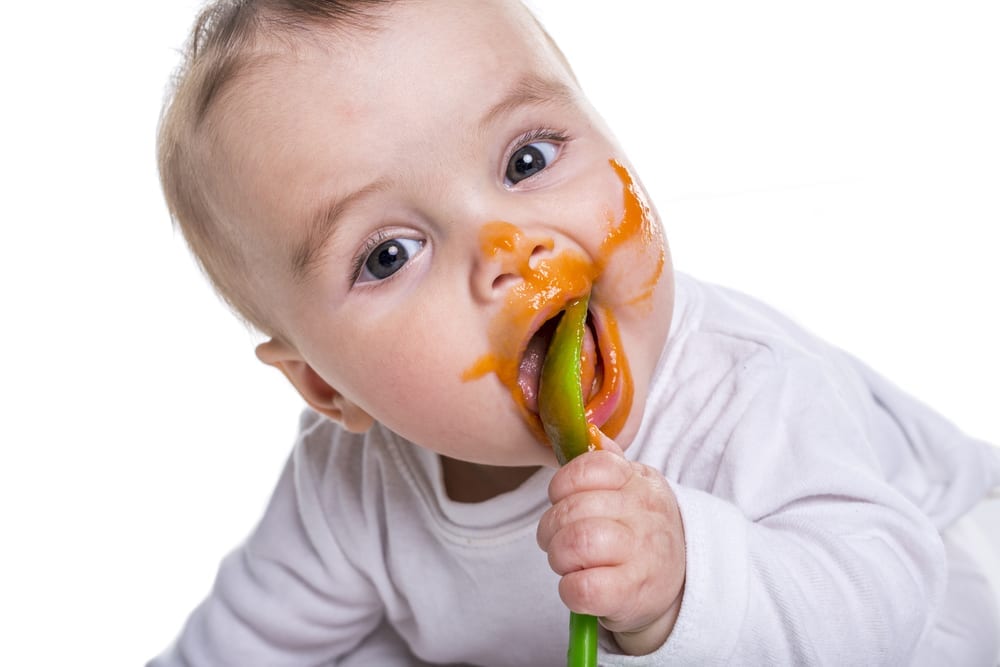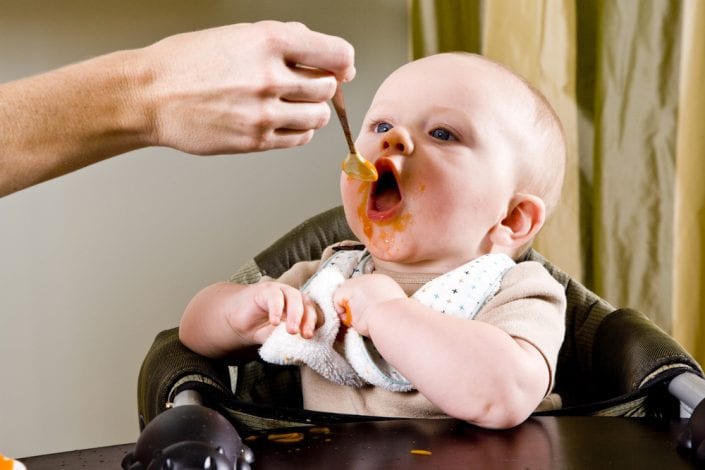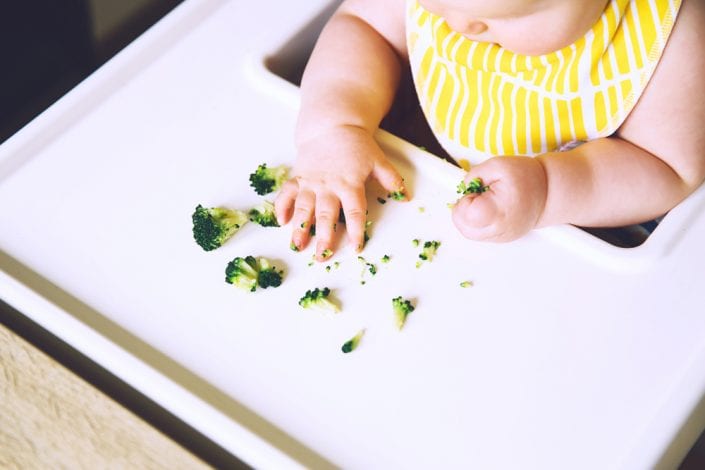Traditionally mums began weaning their babies by pureeing foods and spoon feeding them.
Over the last 15 years there has been a growing trend for mums to skip the pureeing stage altogether and move straight onto offering their child finger foods that they can feed themselves. This is known as baby led weaning.
Gone is the need to spend hours cooking and pureeing food and freezing it in ice cube trays and making aeroplane noises to get your baby to open their tiny mouths and eat a spoonful.
But, should you ditch the blender completely and embrace baby led weaning as the way forward? We take a look at both weaning methods and the pros and cons of each.
 Puree all the way
Puree all the way
As recently as the turn of the millennium this was the way most mums started weaning.
It was almost definitely the way you yourself were first introduced to solid food by your own parents. It’s a tried and tested method of gradually introduce your baby to different tastes and textures.
They can learn to enjoy food and mealtimes. Often mums start the process by mixing baby rice with either breastmilk or formula for an easy introduction to solids.
They then move onto pureed fruits and vegetables before introducing meat and fish. Purees usually begin quite watery, like runny soups, and then are gradually made thicker.
Parents also make them less smooth over the weeks so that their baby gets used to more textures and soft lumps in their food.
Puree pros
- You have a clear idea of how much your child is eating at each meal. You can see how much of the puree in the bowl is left.
- It’s easier to make sure your child has enough of the right nutrients (e.g. vitamins and iron).
- It’s less messy as you spoon feed them.
- You can use pre-prepared jars and pouches when you’re out and about.
Puree cons
- It can take some time to prepare pureed foods and store them.
- As you have to spoon feed, it can take time to coax your child to eat from the spoon.
- You are less able to enjoy mealtimes together and both eat comfortably at the same time.
Baby led mealtimes
All the boiling, blending, freezing, reheating of purees can be a pain in an already busy day.
At its core, baby led weaning is much less of a hassle. You just have to cook whatever you or the rest of the family is eating and chop bits of it up into finger sized chunks for your baby to explore.
Your baby is free to explore their food and independently choose which pieces to pick up and try.
It’s best to start by giving your baby long thin strips of food, which they can pick up and hold easily.
Offer one or two choices at a time, rather than overwhelming them with a whole variety of finger foods.
Baby led pros
- It’s less time consuming.
- Your baby is offered the same food as you so there’s no extra cooking.
- You can both eat at the same time – you’re not tied to spoon feeding while your own food goes cold.
- No transitioning from smooth purees to more lumpy food.
- Your baby can explore many tastes and textures at his own pace.
- Your baby is introduced to a larger number of foods.
- You don’t have to do the flying aeroplane spoon thing to coax your baby to eat.
Baby led cons
- It can be a very messy business.
- You’re never sure exactly how much your child eats at each meal, and they may not be eating enough.
- There can be food wastage (and lots of food dropped on the floor).
- Your baby might just play with their food instead of eating very much of it.
- Eating out is harder if there is not much your child can enjoy.
- There are worries about choking as baby is putting chunks in their mouth.
- Other people’s judgement if they don’t understand baby led weaning.
- You can’t be sure your baby is getting enough nutrients (such as iron) or too much of some nutrients (such as sodium). Never add salt to family meals that you will be giving to your baby.
- Small babies don’t have teeth so gnawing on some foods can take an AGE!
Official advice from the NHS – what they say
The NHS don’t advocate either weaning method but their advice includes:
- let your baby enjoy touching and holding the food.
- allow your baby to feed themselves, using their fingers, as soon as they show an interest.
This suggests that the NHS is supportive of baby led weaning or a mixed approach to weaning including both purees and finger foods after six months.
 Best of both worlds – combining spoon feeding and finger foods
Best of both worlds – combining spoon feeding and finger foods
Some parents – and some babies – prefer spoon feeding when they first start solids.
Babies can be slow to self feed and need to try the same food lots of times before they get used to the taste. You can spoon feed purees and also start introducing finger foods either before, after or during spoon feeding.
That way your baby will be getting enough nutrition from the pureed meal. They will also get the opportunity to feel, smell, squish and taste finger foods.
Early weaning
World Health Organisation (WHO) and NHS guidelines advise new parents to exclusively breastfeed, if possible, for six months.
Even if formula feeding or mixed feeding, they advise to delay weaning until 6 months of age. A number of parents feel that their babies are ready for solids earlier than this. You can read more about this debate in our article When is the best time to wean my baby?
Although weaning a little before 6 months is common, it is only advised to do so after discussing it with your GP or medical practitioner.
Please note that early weaning only refers to introducing solids in the form of purees. Baby led weaning and finger foods are not recommended before six months of age.
This is because baby will not be able to sit unaided. They will also not have developed the fine motor skills to pick up pieces of foods and feed themselves.
Both can pose choking hazards.
Worries about choking
One of the biggest worries for parents whenever their child eats large pieces of finger foods, is choking.
A study in 2017 found that baby led weaning babies are no more likely to choke than babies who are given purees.
If your baby or toddler starts to choke it can be terrifying and parents must take immediate action. It’s worth knowing that Babies have a much stronger gag reflex than adults and spit up food that’s not going down the right way.
It’s also vitally important to always supervise your baby when they are eating and never leave them unsupervised.
Be aware of the key food culprits that can cause choking and always cut them into small pieces to avoid it happening.
Grapes, for example, should always be cut up before being offered to babies or young children.
As a guide, cut any foods that are a similar size to grapes. These could also be a choking hazard so it’s worth keeping an eye out for them.
Also avoid giving babies hard finger foods, such as raw apple and carrot.
The American Academy of Paediatrics (AAP), compiled a list of nine foods that pose a danger of choking for babies and children.
All these foods must be cut into very small pieces before giving to a baby or young child.
- Hot dogs
- Carrots
- Apples
- Grapes
- Nuts
- Peanut butter (it can form to the shape of a child’s airway and stick to its side.)
- Marshmallows
- Hard sweets
- Popcorn
Keep in mind also that foods that expand upon contact with water (and so can swell with saliva) can also be a choking hazard. They can swell and block the oesophagus.
These include foods like melon and banana. If you chop up foods into small pieces and always supervise your baby, then they are unlikely to choke.
However it is worth knowing what to do if they do. Educating yourself can make a very big difference if the worst should happen.
For example, if you put your finger down your child’s mouth to try to unblock the food then you could potentially push the food further down the throat.
It’s better to try to dislodge the food by using back blows and chest thrusts. Hopefully your child will never choke but having an emergency plan of action can make a big difference.
This quick video from St John’s ambulance is very helpful for any parent:
Foods to avoid
Whether you choose to spoon feed or try baby led weaning there are some foods and drinks that you should avoid giving to your baby.
The NHS Start4Life guide provides a handy list of what not to give your baby:
Foods to avoid
- shark, swordfish or marlin – high levels of mercury in these fish can affect your baby’s growing nervous system.
- raw shellfish – this can increase the risk of food poisoning.
- honey – avoid honey until your baby is 12 months old. It contains bacteria that can lead to infant botulism, a serious illness that can make your baby very unwell.
- nuts – avoid giving your baby or toddler [whole] nuts until they are five years old, as they can cause choking.
- raw jelly cubes – they can be a choking hazard.
- sugar and salt – your baby doesn’t need it. Too much salt is bad for their kidneys and sugar can cause tooth decay.
Drinks to avoid
- cow’s, goat’s or sheep’s milk – before your baby is 12 months
- rice drinks – as they may contain unsafe levels of arsenic – until your child is five years old.
- soya drinks – before your baby is 12 months old.
- fruit juice or smoothies – babies younger than 12 months old don’t need fruit juices or smoothies. But if you do choose to offer them, dilute with water (one part juice to 10 parts water) and make sure they’re with a meal.
- squash, fizzy drinks, flavoured milk – these all contain lots of sugar and can cause tooth decay, even when they’re diluted
Once you’ve decided which way to go see our article the Ultimate guide to weaning baby for more information on how to get started.
Remember there’s no hard and fast rule of what’s right between purees and baby led weaning. Every baby is different, and some will respond better to one weaning method over the other.
You can always start one way and adjust accordingly, or start both ways and see how it goes.
Most of all enjoy introducing them to the world of food. And the little faces they pull when they try each new flavour.
After drinking milk for 6 months, eating even the mildest of fruits and vegetables can be quite an experience for them!


 Puree all the way
Puree all the way Best of both worlds – combining spoon feeding and finger foods
Best of both worlds – combining spoon feeding and finger foods